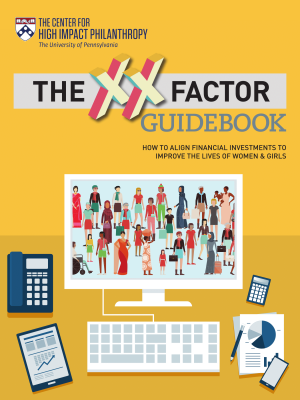Social Impact Goals: Public Equity Alignment with The XX Factor Framework
In 2017, the Center for High Impact Philanthropy published its first-ever comprehensive framework for philanthropic donors committed to improving the lives of women and girls. In it, we identified five dimensions of women’s lives that contribute to their well-being: health, education, economic empowerment, personal safety, and legal rights. We analyzed thousands of indicators and dozens of frameworks and research articles to pinpoint the key determinants of progress in each dimension, along with the consensus indicators used around the world to mark improvement. For donors focused on impact, that framework provides an evidence-based playbook for generating the greatest impact for women and girls.
In this guidebook, we aim to show how our framework can be used to not only guide philanthropic funding decisions, but also help investors align their financial investments with their goals of improving the lives of women and girls. The determinants and outcome measures listed in our framework are, ideally, what should be considered for optimal social impact. For instance, those interested in improving women’s economic status should look at data related to equal pay for equal work or access to reproductive and mental health care. But since financial investments have historically been designed to optimize for financial return and not social impact, we conducted additional analysis to show how our framework could be used to help investors better align with philanthropic goals.
While you can align any part of your investments (stocks, bonds, or cash) to social impact, we focused our analysis specifically on public equity or stocks, given that it typically comprises the largest share of an investor’s portfolio. What emerged, following both qualitative and quantitative research, is guidance on two main strategies for public equity alignment with the XX Factor framework: using available data for stock selection and engaging as a shareholder to influence the companies owned.
For an investor, trying to figure out which stocks to select depends on the types of information that companies are willing to share with investors. Data—or the information that a company shares with investors—is significant because it forms the basis for research and analysis. For this reason, we decided to analyze the relevant social corporate data collected by data providers to identify opportunities and challenges for investors and for the field.
We analyzed 122 data points collected by Bloomberg, L.P.; Equileap; MSCI, Inc.; and Thomson Reuters, and validated our analysis with each of the data providers to gain further insights on their sources, process, coverage, and to learn about their future plans for data collection. Our purpose in doing this is to show investors where to find points of alignment between our framework and available social data about public companies in the marketplace. The reason: the more companies you hold in your portfolio that have these points of alignment, the better the alignment of your portfolio with your philanthropic mission of advancing women.
On the pages linked below, you’ll find a detailed summary of the data available to investors around enhancing the lives of women, as well as a discussion about how to use data to select stocks and engage as a shareholder to influence the companies you own. One of the most important revelations to emerge from our research and analysis is that mission alignment is possible for grants and public equity investments—and infusing our framework into grantmaking guidelines and investment policy statements can lead to better outcomes.

